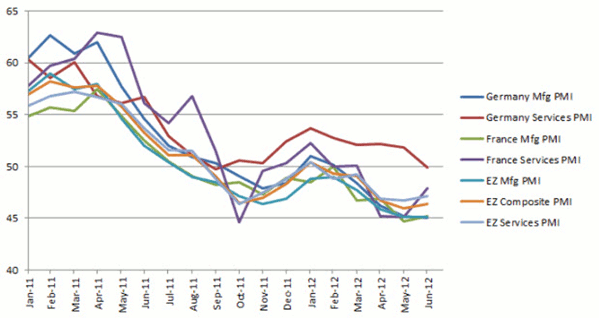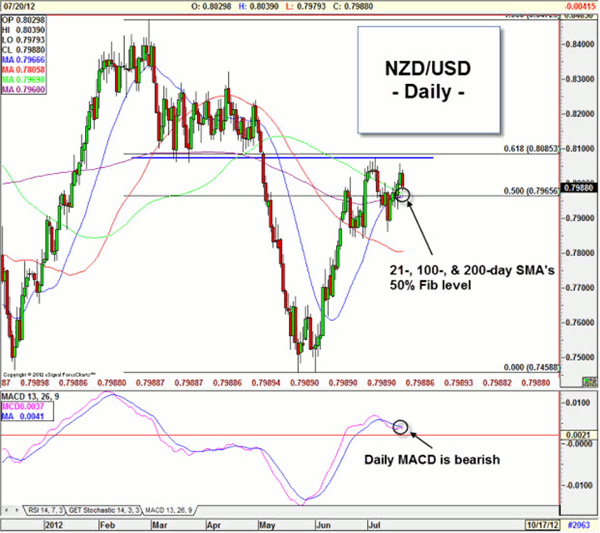Eric Viloria, CMT at Forex.com, oulines the important fundamental and technical issues currency traders are watching this week.
Recent price action across markets has been driven largely by the global growth outlook and policy response, as well as the European debt crisis. Deteriorating growth has weighed on market sentiment, which has provided support to perceived safe havens such as the USD and JPY, while any upside surprises in economic activity tends to support risky assets.
In the week ahead there are several data releases across the globe that will provide more insight into the health of the world economy, as well as the outlook moving forward. The preliminary figures of second-quarter GDP growth will be released out of the UK and the US on Wednesday and Friday respectively. On Tuesday, China and Europe will report July flash PMI readings.
China’s unofficial flash manufacturing PMI for July is due out on Tuesday and is likely to remain below the 50 threshold, indicating further contraction (last at 48.2). China’s economy, which is the second largest in the world, has been in the spotlight recently as economic activity has slowed and the People’s Bank of China (PBoC) has reacted with interest rate reductions.
The continued slowdown in China has put pressure on commodity prices, as global demand weakens, and caused investors to speculate on further easing from the PBoC. More stimulus from Chinese officials would be viewed as supportive for risky assets, while disappointing economic data is likely to weigh on sentiment.
The Eurozone, France, and Germany will report advance service and manufacturing PMI readings next week, and the outlook is expected to remain weak. All readings are currently below the 50 level and consensus estimates show that broad market expectations are for the readings to remain largely unchanged.
Prolonged contraction in European economic activity is a factor that can keep the common currency under pressure. EUR/USD made a new two-year low on Friday, as Spain cut its growth forecasts and Valencia, a Spanish region, prepared to seek aid. The 1.20 psychological big figure in EUR/USD looks increasingly likely as the pair continues to grind lower.
The recession in the UK is expected to have extended through Q2, with a quarterly decline of -0.2% from the prior -0.3%, which would bring the year-over-year contraction to -0.3% (prior -0.2%). In the US, quarter-to-quarter annualized GDP is forecasted to slow to 1.4% in Q2 from 1.9%, amid a drop in personal consumption. Consecutive declines in retail sales over the months that comprise Q2 (-0.5%, -0.2%, and -0.5% in April, May, and June respectively) have suggested a sharp fall in consumption.
The Fed’s most recent projection for growth this year is between 1.9%-2.4% and a weak labor market which discourages personal consumption is something the Bank has struggled with. Unless a pickup in the pace of job growth is seen over the coming months, we believe that the Fed may need to ease monetary policy further.
Exhibit 1: European PMIs remain below the 50 level:
Up Next: QE3: Will They or Won’t They?...
|pagebreak|QE3: Will They or Won’t They?
This past week, Fed Chairman Ben Bernanke testified before Congress and expressed his frustration with the sluggish labor market and dissatisfaction with the overall pace of the recovery. Bernanke said that the Fed is prepared to act if the labor market doesn’t improve, and laid out various options available to the Bank.
Within the “range of possibilities” for more easing, the Fed Chairman indicated that the Bank can cut interest on excess reserves, push out the length of its low interest rate pledge in Fed communications, use the discount window, and purchase Treasuries and/or mortgage-backed securities (QE3).
We believe that the Fed will remain on hold at the next FOMC meeting which concludes on August 1. The policy decision comes before the next release of the all-important Bureau of Labor Statistics (BLS) monthly employment report.
Weekly jobless claims (which disappointed with a 34,000 increase to 386,000 this week) can provide an indication of the direction of the labor market, but the BLS report is much more comprehensive and therefore carries more weight. While the probability of more QE has been increasing amid deteriorating data, we would not consider it a likelihood at this time.
The Fed extended its Operation Twist program at the last meeting, and Bernanke’s stance on additional measures has been noncommittal, as the Bank buys time while central banks around the world ease. After all, Bernanke indicated that much of the global slowdown is originating from Europe, and that the world is in an easing cycle.
It seems as the Bank is on the sidelines and allowing other major central banks to do the heavy lifting in hopes that global demand picks up and feeds back into the US economy. Persistent labor market weakness such as sub-100,000 monthly job growth and stubbornly high unemployment would increase probability of QE3, and would cause us to reassess our view.
Reserve Bank of New Zealand to Hold
On Thursday, the Reserve Bank of New Zealand (RBNZ) will announce the official cash rate and release its monetary policy statement. We expect the Bank to keep rates on hold at 2.50%, with the risk of a more dovish statement.
Since the June 14 decision where the Bank noted it will be monitoring developments abroad, external demand has softened and the euro-area crisis has escalated. Domestically, inflation has slowed to 1.0% year-over-year in Q2 (the bottom of the RBNZ’s target range), the trade surplus narrowed in May, and housing activity has slowed.
The NZD has strengthened against all of the G10 currencies except for the Aussie since the last interest rate announcement, and NZD/USD has advanced to levels which may be cause for concern by the RBNZ. At the April meeting, the bank noted the strength of the exchange rate, and said that a persistent strong currency would cause the Bank to “reassess the outlook for monetary policy”.
Then, NZD/USD was just above the 0.81 figure and EUR/NZD was around 1.62. Currently, NZD/USD is around the 0.80 level and EUR/NZD is trading at record lows.
Overall, we believe there is risk for the statement to be more dovish, which could weigh on the kiwi. NZD/USD sees a long-term horizontal pivot just below the 0.81 figure and faces key support around a cluster of daily simple moving averages around the 0.7960/70 area (this is where the 21-, 100-, and 200-day SMAs converge).
Also, the 50% Fib retracement of the entire 2012 range is around 0.7965. A break below this level would be bearish from a technical perspective, and likely see further downside potential. NZD/USD is facing key support around 0.7960/70
Eric Viloria, CMT, can be found at Forex.com.























